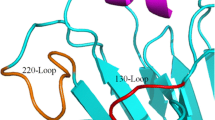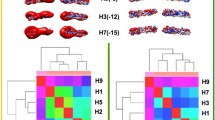Abstract
Positive selection and differential selective pressure analyses were carried out to study Haemagglutinin (HA) genes of H9N2 influenza viruses from different hosts in this paper. Results showed that, although most positions in HAs were under neutral or purifying evolution, a few positions located in the antigenic regions and receptor binding sites were subject to positive selection and some of them were even positively selected at the population level. In addition, there were always some positions differentially selected for viruses from different hosts. Both selection pressure working on HA codons and positions differentially selected might account for the extension of the host range and adaptations to different hosts of H9N2 influenza viruses.
Similar content being viewed by others
References
Amonsin A, Payungporn S, Theamboonlers A, et al. 2006. Genetic characterization of H5N1 influenza A viruses isolated from zoo tigers in Thailand. Virology, 344: 480–491.
Bush R M, Fitch W M, Bender C A, et al. 1999. Positive selection on the H3 hemagglutinin gene of human influenza virus A. Mol Biol Evol, 16: 1457–1465.
Campitelli L, Ciccozzi M, Salemi M, et al. 2006. H5N1 influenza virus evolution: a comparison of different epidemics in birds and humans (1997–2004). J Gen Virol, 87: 955–960.
Choi Y K, Ozaki H, Webby R J, et al. 2004. Continuing Evolution of H9N2 Influenza Viruses in Southern China. J Virol, 78: 8609–8614.
Fitch W M, Leiter J M E, Li X, et al. 1991. Positive Darwinian evolution in human influenza A viruses. Proc Natl Acad Sci USA, 88: 4270–4274.
Gambaryan A, Yamnikova S, Lvov D, et al. 2005. Receptor specificity of influenza viruses from birds and mammals: new data on involvement of the inner fragments of the carbohydrate chain. Virology, 334: 276–283.
Guan Y, Shortridge K F, Krauss S, et al. 2000. Molecular characterization of H9N2 influenza viruses: Were they the donors of the “internal” genes of H5N1 viruses in Hong Kong? Proc Natl Acad Sci USA, 96: 9363–9367.
Guindon S, Gascuel O. 2003. A simple, fast, and accurate algorithm to estimate large phylogenies by maximum likelihood. Syst Biol, 52: 696–704.
Ilyushina N A, Rudneva I A, Gambaryan A S, et al. 2004. Receptor specificity of H5 influenza virus escapemutants. Virus Res, 100: 237–241.
Ina Y, Gojobori T. 1994. Statistical analysis of nucleotide sequences of the hemagglutinin gene of human influenza A viruses. Proc Natl Acad Sci USA, 91: 8388–8392.
Keawcharoen J, Oraveerakul K, Kuiken T, et al. 2004. Avian Influenza H5N1 in Tigers and Leopards. Emerg Infect Dis, 10: 2189–2191.
Kosakovsky Pond S L, Frost S D W. 2005. Not So Different After All: A Comparison of Methods for Detecting Amino Acid Sites Under Selection. Mol Biol Evol, 22: 1208–1222.
Kosakovsky Pond S L, Frost S D W, Grossman Z, et al. 2006. Adaptation to different human populations by HIV-1 revealed by codon-based analyses. PLoS Comp Biol, 2: e62.
Kosakovsky Pond S L, Frost S D W, Muse S V. 2005. HyPhy: hypothesis testing using phylogenies Bioinformatics, 21: 676–679.
Matrosovich M N, Krauss S, Webster R G. 2001. H9N2 influenza A viruses from poultry in Asia have human virus-like receptor specificity. Virology, 281: 156–162.
Perez D R, Lim W, Seiler J P, et al. 2003. Role of Quail in the interspecies trans-mission of H9 influenza A viruses: molecular changes on HA that correspond to adaptation from ducks to chickens. J Virol, 77: 3148–3156.
Scholtissek C, Burger H, Kistner O, et al. 1985. The nucleoprotein as a possible major factor in determining host specificity of influenza H3N2 viruses. Virology, 147: 287–294
Shi W F, Gibbs M J, Zhang Y Z, et al. 2008. Genetic Analysis of Four Porcine Avian Influenza Viruses Isolated from Shandong, China. Arch Virol, 153: 211–217.
Webster R G, Bean W J, Gorman O T, et al. 1992. Evolution and ecology of influenza A viruses. Microbiol Rev, 1992, 56: 152–179.
Yang Z H, Nielsen R, Goldman N, et al. 2000. Codon-Substitution Models for Heterogeneous Selection Pressure at Amino Acid Sites. Genetics, 155: 431–449.
Author information
Authors and Affiliations
Corresponding author
Rights and permissions
About this article
Cite this article
Shi, Wf., Dun, As., Zhang, Z. et al. Selection pressure on Haemagglutinin genes of H9N2 influenza viruses from different hosts. Virol. Sin. 24, 65–70 (2009). https://doi.org/10.1007/s12250-009-2988-5
Received:
Accepted:
Published:
Issue Date:
DOI: https://doi.org/10.1007/s12250-009-2988-5




